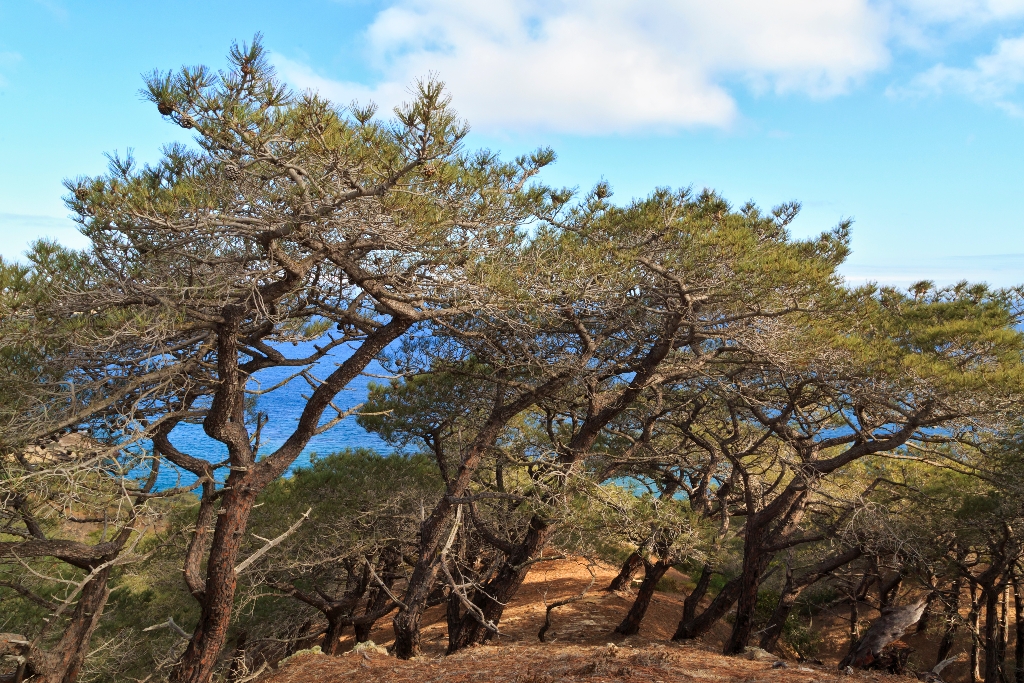
The Torrey pine is the rarest native pine in the United States and, possibly, the rarest pine in the world. It only grows naturally in two places. One is here on Santa Rosa Island and the other is near San Diego. Scientists think that it never was a very abundant pine, probably always needing to be near the coast, but they do believe that in the past it occurred in more places along the coast. Unfortunately, specific places cannot be identified because of lack of fossil records. Furthermore, at the moment, it is not known which Torrey pine forest (Santa Rosa Island or San Diego) is the oldest.
There is much debate on how and when the Torrey pine arrived on Santa Rosa Island. To date, researchers have yet to agree on an arrival date. Some have suggested several million years ago while others have suggested between 5,000 and 43,000 years ago. The seeds were most likely transported from the mainland by birds, possibly jays that are known to transport seeds a long distance, or possibly by cones floating across the ocean. The other possible explanation is that the Chumash or their ancestors brought them over. The Chumash were excellent seamen and traders and they did use Torrey pines. If that is true, the trees couldn't be much more than 13,000 years old (since this is the oldest human date from the islands). However, until it can be established by either fossil evidence or genetic variation that the trees were here before the Chumash, this possibility cannot be discounted.
Thousands of years of isolation on Santa Rosa made this island version of the Torrey pine distinct. It is genetically different enough from the mainland trees that it is considered a separate subspecies and given its own common name-the Santa Rosa Island Torrey pine (subspecies differ from each other in various ways but if crossed will produce fertile offspring). This island tree grows shorter, broader, and bushier than the mainland one. Also, its bark is thicker and scalier and its cones are rounder. They both have needles in clusters of five, but the pines on the island have blue-gray needles while those on the mainland are gray.
Most scientists agree that the climate changed to a hotter and drier environment between 3,000 and 8,000 years ago, which may have caused a decrease in the number of Torrey pine forests, particularly on the mainland. The pines most likely survived here because of the cool, moist air from the persistent island fog and because of the limited competition from other plants-due to the island's isolation, a smaller number of plant species exist on the island as compared to the mainland.
The Santa Rosa Island Torrey pine has a very limited range on the island. It only occurs on two sandstone bluffs in the northeast corner of the island. One is on the ridge overlooking Bechers Bay and the other is Box Canyon, one canyon over to the south. This limited range along with its limited individual genetic variability-all these trees are basically identical to each other-makes the Torrey pine very vulnerable to extinction. Species with little or no genetic variability cannot respond as satisfactorily to environmental changes-drought, a new disease, or insect pests-as can species with a more diverse gene pool.
This is why the park closely monitors the health of the Torrey pines. And so far all studies have indicated that the pines are doing very well. In 1888, when the island Torrey pine was first described, the population of the grove was heavily impacted by sheep and was estimated to be about 100 mature, reproductive trees. With the removal of the sheep by 1910, the grove expanded to 1,500 trees by the mid-1990s and by 2015, the population increased to 3,500 trees and over 8,500 seedlings. Some of the oldest trees are in the heart of the grove and have been dated to over 250 years old.
Is there something we missed for this itinerary?
Itineraries across USA


















































